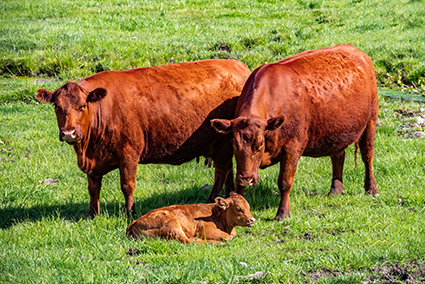Timing matters: It pays to get more cows bred in the first 21 days
By Dr. Todd Bilby
Reproduction in beef cattle is 10 times more economically important than growth traits. It’s 20 times more important than carcass traits. An extra calf, or more calves per cow herd, is the single largest factor in increasing pounds of beef.
Getting cows and heifers pregnant in a timely manner is critical to reaping economic advantages. For every 21 days cows are open, we lose somewhere between 20 and 60 pounds of weaning weight. More calves born in the first 21 days of calving season means more profit potential.

A decade of records were analyzed to determine the effect of the calving period on heifer and steer progeny at Gudmundsen Sandhills Laboratory in Whitman, Nebraska.1 Progeny were classified as being born in the first, second or third 21-day period of the spring calving season.
The research showed that heifer calves born during the first 21 days of the spring calving season had greater weaning, prebreeding and precalving body weight; greater percent cycling before breeding; and greater pregnancy rates. Similarly, steer calves born earlier in the calving season had greater weaning body weight, carcass weight and marbling scores.
Synchronization benefits bull breeding programs
Another study aimed to determine the effect of estrous synchronization on calving distribution and the impact of time of calving on carcass characteristics.2
The study compared calves from nonsynchronized 60-day breeding seasons with calves from estrous synchronized 45-day breeding seasons. Estrus was synchronized using a single injection of prostaglandin administered 108 hours after mixed-age bulls were turned in with the cow herd.
Data showed that more synchronized cows calved during the first 21 days, and calves born to synchronized dams were 20 pounds heavier at weaning. Calves born in the first 21 days of the calving season had greater carcass weights, marbling scores and yield grades than later-born calves. In addition, the percentage of steers grading premium choice or greater, and the total carcass value declined as time of calving increased.
The data showed that one shot of prostaglandin at 4-5 days after bull turnout resulted in cows coming into estrus sooner. This gave the cows a better opportunity to get pregnant earlier, and therefore, more calved in the first 21 days of the calving season. Their calves were heavier at weaning and produced a heavier, more valuable carcass that was worth an additional $77 at the feedlot.
If that protocol won’t fit your management system, one shot of prostaglandin at turnout will still induce more cows to show heat sooner.
ESTRUMATE® (cloprostenol injection) is a leading prostaglandin that is approved for estrus synchronization of cows and replacement heifers.
Fixed-time AI solutions
FERTAGYL® (gonadorelin) and ESTRUMATE help deliver optimal reproductive results in a fixed-time artificial insemination (FTAI) program. FERTAGYL is now approved for use with closprostenol sodium to synchronize estrous cycles to allow for FTAI in beef cows.
Pregnancy rate to FTAI was significantly higher in cows treated with FERTAGYL than in cows treated with control. ESTRUMATE has a long half-life of three hours.3 Consult your veterinarian for recommendations on heat synchronization protocols.
Important Safety Information
ESTRUMATE: Women of childbearing age, asthmatics, and persons with respiratory problems should exercise extreme caution when handling ESTRUMATE. ESTRUMATE is readily absorbed through the skin and may cause abortion and/or bronchospasms; direct contact with the skin should be avoided and accidental spillage on the skin should be washed off immediately with soap and water. Do not administer ESTRUMATE to a pregnant cow if abortion is not desired. Severe localized post-injection clostridial infections have been reported; in rare instances infection has led to death. At 50 and 100 times the recommended dose, mild side effects may be detected. For complete information on ESTRUMATE, see package insert.
FERTAGYL: Not for use in humans. Keep out of reach of children.
References
- Funston, R. N., Musgrave, J. A., Meyer, T. L., and Larson, D. M. “Effect of calving distribution on beef cattle progeny performance.” J. Anim. Sci. 2012; 90:5118-5121.
- Larson, D. M., Musgrave, J. A., Funston. R.N. “Estrous Synchronization Increases Early Calving Frequency, Which Enhances Steer Progeny Value.” Nebraska Beef Report. 2010:14-16.
- European Agency for the Evaluation of Medicinal Products, Committee for Veterinary Medicinal Products, Cloprostenol and R-Cloprostenol Summary Report, 1997.
Find more content for your beef operation.
About the author

Dr. Todd Bilby, Ph.D.
Cattle Technical Services,
Merck Animal Health
